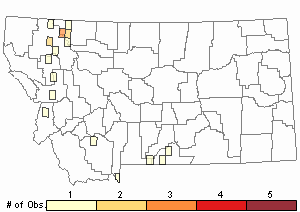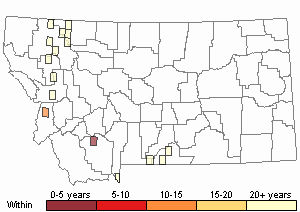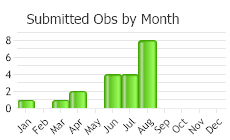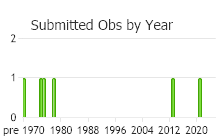View in other NatureServe Network Field Guides
NatureServe
Montana
Utah
Wyoming
Idaho
Wisconsin
British Columbia
South Carolina
Yukon
California
New York
A Ptychostomum Moss - Ptychostomum creberrimum
Other Names:
Bryum lisae var. cuspidatum, Bryum creberrimum
General Description
Plants: Acrocarpous (Vitt 1988). Growing in loose to crowded large patches of erect shoots, green, sometimes with yellow tones. Stems mostly 1-2 cm, with leaves dense at the top of the stem (comose), and frequently with numerous rhizoids (FNA 2014).
Leaves: Larger at the distal end of the stem (FNA 2014), the tips of the upper stem leaves frequently spiraled and curved and those of the lower stem leaves plicate, upright and overlapping when dry (Flowers 1973), upright or spreading somewhat when moist, plane to shallowly cupped, lance-shaped, or sometimes tending toward egg-shaped, mostly 2-3 mm in length (FNA 2014), the leaf tip long-acuminate (Crum & Anderson et al. 1981); margins rolled tightly back and downward proximally to half or more of the leaf length, the border well-defined (FNA 2014); costa red basally (Crum & Anderson et al. 1981), extending well beyond the leaf apex to form an awn, the awn mostly smooth (FNA 2014) or finely saw-toothed (Crum & Anderson et al. 1981).
Leaf Cells: Middle and upper laminal cells diamond-shaped, 3-4:1 (FNA 2014), occasionally nearly linear in the acumen (Crum & Anderson et al. 1981), the walls fine or slightly thicker (firm), as wide as or narrower than the proximal laminal cells; proximal cells rectangular, 3-4:1; border (limbidium) consisting of 2-3 rows of somewhat yellow cells, unistratose (FNA 2014).
Phenology
Fruit ripens spring through late summer or early fall (FNA 2014).
Diagnostic Characteristics
Unlike Bryum lonchocaulon, which is mixed synoicous, polygamous, or producing only antheridia, B. lisae var. cuspidatum is faithfully synoicous. It also has more slender margins (of 2-3 cell rows rather than 2-6 rows) (FNA 2014).
Range Comments
North American Range
Throughout Canada and the United States except in the southeastern states from LA to SC and FL. Common, with an extensive range (FNA 2014). Known in Montana from Carbon, Cascade, Flathead, Gallatin, Glacier, Lake, Lewis and Clark, Madison, Missoula, and Park Counties (Elliot 2016).
Observations in Montana Natural Heritage Program Database
Number of Observations: 23
(Click on the following maps and charts to see full sized version)
Map Help and Descriptions
Relative Density

Recency



 (Observations spanning multiple months or years are excluded from time charts)
(Observations spanning multiple months or years are excluded from time charts)
Habitat
Dry to moist soil and soil overlying stones. Elevation: 0-11,480 feet (FNA 2014).
Reproductive Characteristics
Synoicous. Seta 1-3 cm tall. Capsule somewhat long and pear-shaped (FNA 2014), the neck short, the capsule drooping (Crum & Anderson et al. 1981), 2-4 mm in length, brown, the opening brown; exostome teeth yellow below, transparent above; endostome segments with widely ovate openings, the cilia long and transversely ridged (FNA 2014).
No specialized vegetative reproduction present (FNA 2014).
Stewardship Responsibility
References
- Literature Cited AboveLegend:
 View Online Publication
View Online Publication Crum, H.A. and L.E. Anderson. 1981. Mosses of Eastern North America. 2 volumes. Columbia University Press, New York. 1328 pp.
Crum, H.A. and L.E. Anderson. 1981. Mosses of Eastern North America. 2 volumes. Columbia University Press, New York. 1328 pp. Elliott, J.C. and A.K. Pipp. 2018. A Checklist of Montana Mosses (1880-2018). Updated 3 January, 2020. Montana Natural Heritage Program, Helena, Montana. 73 pp.
Elliott, J.C. and A.K. Pipp. 2018. A Checklist of Montana Mosses (1880-2018). Updated 3 January, 2020. Montana Natural Heritage Program, Helena, Montana. 73 pp. Flora of North America Editorial Committee, eds. 2014. Flora of North America North of Mexico. Volume 28. Bryophytes: Mosses, Part 2. Oxford University Press, Inc., NY. xxi + 702 pp.
Flora of North America Editorial Committee, eds. 2014. Flora of North America North of Mexico. Volume 28. Bryophytes: Mosses, Part 2. Oxford University Press, Inc., NY. xxi + 702 pp. Flowers, S. 1973. Mosses: Utah and the West. Brigham Young University, Provo, Utah. 567 p.
Flowers, S. 1973. Mosses: Utah and the West. Brigham Young University, Provo, Utah. 567 p. Vitt, D. J. Marsh, and R. Bovey. 1988. Mosses, Lichens & Ferns of Northwest North America. Seattle, WA: University of Washington Press. 296 p.
Vitt, D. J. Marsh, and R. Bovey. 1988. Mosses, Lichens & Ferns of Northwest North America. Seattle, WA: University of Washington Press. 296 p.
- Additional ReferencesLegend:
 View Online Publication
View Online Publication
Do you know of a citation we're missing? Elliot, J. C. 1993. Second checklist of Montana mosses. Unpublished report. U.S. Forest Service, Region 1. Missoula, MT. 45 pp.
Elliot, J. C. 1993. Second checklist of Montana mosses. Unpublished report. U.S. Forest Service, Region 1. Missoula, MT. 45 pp. Lawton, E. 1971. Keys for the Identification of the Mosses on the Pacific Northwest. Reprinted from 'Moss Flora of the Pacific Northwest'. Published as Supplement No. 2 of the Journal of the Hattori Botanical Laboratory. Nichinan, Miyazaki, Japan. 66 pp.
Lawton, E. 1971. Keys for the Identification of the Mosses on the Pacific Northwest. Reprinted from 'Moss Flora of the Pacific Northwest'. Published as Supplement No. 2 of the Journal of the Hattori Botanical Laboratory. Nichinan, Miyazaki, Japan. 66 pp. Lawton, E. 1971. Moss Flora of the Pacific Northwest. Hattori Botanical Laboratory. Japan: Yamabuki-cho, Shinjuku-ku, Tokyo. 362 pages plus appendices.
Lawton, E. 1971. Moss Flora of the Pacific Northwest. Hattori Botanical Laboratory. Japan: Yamabuki-cho, Shinjuku-ku, Tokyo. 362 pages plus appendices. Malcolm, B., N. Malcolm, J. Shevock, and D. Norris. 2009. California Mosses. Nelson, New Zealand: Micro-Optics Press. 430 pp.
Malcolm, B., N. Malcolm, J. Shevock, and D. Norris. 2009. California Mosses. Nelson, New Zealand: Micro-Optics Press. 430 pp. Smith, A.J.E. 1980. The Moss Flora of Britain and Ireland. Cambridge University Press, Cambridge. 705 pp.
Smith, A.J.E. 1980. The Moss Flora of Britain and Ireland. Cambridge University Press, Cambridge. 705 pp.
- Web Search Engines for Articles on "A Ptychostomum Moss"





